|
PALM SUNDAY
CULTURAL RESOURCES
Sunday, April 1, 2012
Sr. Jamie T. Phelps, OP, Guest Cultural Resource Writer
I. Word Etymology
Palm from the Old English, Palma, and Old French palme both from the Latin L. Palma, Fr. Palme refers to a “tropical tree” whose leaves resemble the palm of the hand.1 While Palm Sunday is the most prominent name for the memorial of Jesus’ entrance into Jerusalem in most European Countries, the Palm is not available and so the name varies also as “Branch Sunday” or “Willow Sunday” in a manner reflective of the plant life of the region.
II. The History, Historical Documents Section
The biblical foundations for the celebration of Palm Sunday are found in all four Gospels: Matthew 21:1-9, Mark 11:1-10, Luke 19:11-27, and John 12:12-19. The synoptic accounts describe Jesus’ entrance into Jerusalem riding on an ass or colt as large crowds waved branches and chanted “Hosanna to the one who comes in the Name of the Lord!”
Church historians from various Christian traditions indicate that Palm Sunday was not celebrated formally by the Christian church until sometime between the 4th and 10th centuries.2 Palm Sunday was the initial historical high point for the members of the Jewish community. These members of the oppressed nation of Israel had waited throughout their history for the Messiah. Their hope for the coming of the Messiah was realized by the coming of Jesus as Messiah. Their joyous shouts, “Hosanna to the Son of David, blessed is he who comes in the name of the Lord,” and their palm waving indicate the solemnity and joy of the moment of recognition of Jesus as he entered Jerusalem humbly riding on a colt.
After three years of public ministry in which Jesus had healed the sick, raised the dead, and proclaimed the coming of the Kingdom, finally a significant number of the people understood Jesus’ earlier prophetic preaching: “I have a witness greater than John’s testimony. The Father has given me works to do so that I might complete them. These works I do testify about me that the Father sent me” (John 5:36). Jesus was he whose coming John the Baptist had foretold. The people were ecstatic with joy and praised and welcomed Jesus.
Palm Sunday celebrates that glimpse of God’s presence and commitment to our salvation that we experience in our daily lives already but not fully realized. As Christians we struggle like our religious ancestors to glimpse the mystery and majesty of Jesus, though we are limited in doing so by our finite humanity. Then, we endure periods of spiritual passivity and blindness as we become distracted by the demands of life and fail to see God’s presence (grace) in the depth and dimensions of our ordinary human experiences.
Palm Sunday provided the community of Israel, our religious ancestors, a similar historical brief awareness of Jesus’ identity. Yet the community was divided. Some were unable to perceive Jesus’ identity as the Messiah.
The first Palm Sunday was the prelude to the Passion and Death of Jesus. This is the essence of the Paschal Mystery—the happiness of earthly encounters are sometimes replaced by the excruciating pain of a death. Crown and cross commingle. These are the essential movements of our spiritual journey with Christ. Followers of Christ must walk all the way with Jesus. Palm Sunday is also a momentary recall of the joy of our baptism when we joyously pledged to follow the Way of Jesus.3
Salvation of the Nation and the World Community
Many African Continental, Latin American, and African American men and women and members of other national or cultural groups live in situations of social or religious oppression either by being a target of stereotypic group condemnation (Black or Islamic Muslims) or because they are relegated to invisibility or rendered insignificant and kicked to the invisible margins of the dominant religious and cultural groups within their nation. Those being made invisible are the economically poor in our midst and throughout the world. These devalued, racially, religiously, economically marginalized people identify with God’s promise to refugees. Salvation is not a solitary journey but is God gathering us into eternal communion with himself and one another as an eternal communion of love.
Marginalized Christians and others have cause to celebrate, knowing that God’s ways are not consistent with the ways of the prevailing society. God sees and identifies with the marginalized poor and oppressed peoples of our nation and world even when the dominant culture does not. African American Christian history, hymns, poetry, and literature document our historical awareness that Jesus entered the lives our cultural ancestors and enabled them to survive religious, class, and ethnic hatred down through the years. They did so by maintaining a sense of God’s promise to save them as a community.
In a similar way, poor African American women and men who are challenged by the historical “inter” and “intra” ethnic, racial, class, and religious national indifference and oppression are assured of God’s universal salvific love and redemption. We are each called to embody that universal salvific love which makes us a community of faith committed to follow the Way of Jesus.
Men and women of faith who believe and hope in God with all their heart will encounter God in their midst through the poor, the marginalized , the maligned and homeless people of our nation and world. We know well how God fulfilled the promises he made to the nation of Israel in Isaiah 45:1-17. This same God assures the Gentiles in Isaiah 45:20-25 (our Scripture for today) that God’s salvation is universal. He will save both the Israelites and the Gentiles who turn to him to be saved.
(v. 20) Gather together and come; assemble, you fugitives from the nations. Ignorant are those who carry about idols of wood, who pray to gods that cannot save. (v. 21) Declare what is to be, present it—let them take counsel together. Who foretold this long ago, who declared it from the distant past? Was it not I, the Lord? And there is no God apart from me, a righteous God and a Savior; there is none but me. (v. 22) Turn to me and be saved, all you ends of the earth; for I am God, and there is no other. (v. 23) By myself I have sworn, my mouth has uttered in all integrity a word that will not be revoked: Before me every knee will bow; by me every tongue will swear. (v. 24) They will say of me, ‘In the Lord alone are righteousness and strength. All who have raged against him will come to him and be put to shame.’ (v. 25) But in the Lord all the descendants of Israel will be found righteous and will exult.4
Our African American Christian ancestors who lived with eyes of faith perceived God’s palpable presence in their individual and collective past even in the midst of oppression. Christian love helped them sense the Spirit’s presence in the ordinary interpersonal and social-cultural experiences of their lives. Their spiritual hope allowed them to maintain trust in Jesus in the midst of deep turmoil, hopelessness, and tribulation. It is this legacy of faith, love, and hope that has been passed on to those who are attentive to God’s presence (grace) within them and in the ordinary experience of our daily lives.
The faithful remnant will not forsake the God who sustained our ancestors . The redemptive and saving power that God promised to our Jewish and Gentile ancestors in Isaiah 45 is the same redemptive and saving power we experience daily and which is celebrated on Palm Sunday. Jesus invites us to “Turn to (Him) and be saved, all you ends of the earth; for I am God, and there is no other.”
III. We Have This Hope . . .
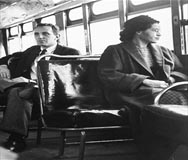
It was this hope spoken of above that enabled Rosa Park to take the only seat available in the “white section” of the segregated Alabama bus, a courageous act that sparked the modern Civil Rights Movement.
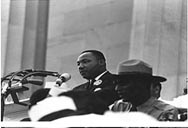
It was this hope shared by our non-black brothers and sisters who suffered the oppression of poverty and social exclusion which also fueled and stirred the modern Civil Rights Movement led by Martin Luther King Jr. in the 1960s.

It was this hope that galvanized black people and white people, Native Americans, Asians, Latinos, and young and old to elect President Obama in 2008 as he articulated a vision of hope and justice for all.
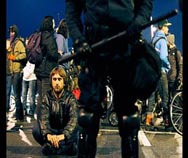
It is this hope that fuels the protest movements that erupted in Northern Africa, in the Arab Nations, on the streets of Europe, and in America through the “Occupy” movement at the dusk of 2011 and the dawn of 2012.

It is this hope that empowers our young African American adult men and women to remain in college even when the pressure of balancing the demands of work, study, and social engagement and the difficulties of finding a job during the recent economic down-turn seems overwhelming.
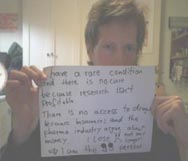
It is this hope that allows us to keep on moving in the midst of the economic down-turns that are engulfing the world and forcing the “middle class” to experience the challenges that working class, poor, under-employed, and unemployed African Americans and Native Americans have endured for centuries. Shared suffering may yet forge a bond of shared hope for the masses of the human community.
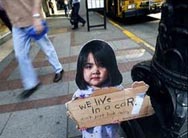
It is this hope that allows the homeless to keep on keeping on until they find a “home” within themselves and among those who walk with them.

It is this hope and the care of family and friends that motivate the addicted to rend their self-destructive pattern of addiction to drugs and establish a new pattern of self-love and reclaim their passion for life, surrounded by constructive relationships with God and others.
IV. What the Paschal Mystery Helps Us Recall
Palm Sunday helps us recall that being a follower of Christ is an experience of joy that transcends all suffering or challenges. It is this experience of joy in doing God’s will that we hope to transmit to those whom God sends to us for help. As members of the human community in general and the black community in particular, we can do all things by the power of God working in us. We are each called to embody the Paschal Mystery living with a spirit of faith, hope, and joyous love in the midst of violence, suffering, and death.
The Hosannas of Palm Sunday and the promises of Isaiah 45 remind us that God is always working in us enabling us to do more than we can ask or imagine. Our experiences of happiness, disappointment, struggling, and pain do not overwhelm us because we have experienced the blessed assurance that God is in our midst bringing all to fruition. We can accompany Jesus through the peaks of joy that include that first Palm Sunday and Holy Thursday, and also the valley of suffering and death on Friday, because we are certain that communion with God and the family of God for all eternity will be the final word! As we celebrate seeing God’s face and the faces of our deceased loved ones, God has promised to be our refuge in times of trouble, and he has never gone back on his word.
V. Poetry for This Calendar Moment
Blessed Hope by Frances E.W. Harper
Oh! crush it not, that hope so blest,
Which cheers the fainting heart,
And points it to the coming rest,
Where sorrow has no part.
Tear from my heart each worldly prop,
Unbind each earthly string,
But to this blest and glorious hope,
Oh! let my spirit cling.
It cheer’d amid the days of old,
Each holy patriarch’s breast;
It was an anchor to their souls,
Upon it let me rest.
When wandering in dens and caves,
In sheep and goat skins dress’d,
A peel’d and scatter’d people learned
To know this hope was blest.
Help me, amid this world of strife,
To long for Christ to reign,
That when He brings the crown of life,
I may that crown obtain.5
VI. Songs That Speak to the Moment
(a) All Glory, Laud, and Honor
Refrain:
All glory, laud and honor,
To Thee, Redeemer, King,
To Whom the lips of children
Made sweet hosannas ring.
Verse 1:
Thou art the King of Israel,
Thou David’s royal Son,
Who in the Lord’s Name comest,
The King and Blessed One.
Verse 2:
The company of angels
Are praising Thee on High,
And mortal men and all things
Created make reply.
Verse 3:
The people of the Hebrews
With palms before Thee went;
Our prayer and praise and anthems
Before Thee we present.
Verse 4:
To Thee, before Thy passion,
They sang their hymns of praise;
To Thee, now high exalted,
Our melody we raise.
Verse 5:
Thou didst accept their praises;
Accept the prayers we bring,
Who in all good delightest,
Thou good and gracious King.6
(b) Congregational Hymn – Recessional Hymn
Ride On, King Jesus
Ride on, King Jesus
No man can a-hinder me
Ride on King Jesus, ride on
No man can a-hinder me
I was young when I begun
No man can a-hinder me
But now my race is almost run
No man can a-hinder me
King Jesus rides on a milk white horse
No man can a-hinder me
The river Jordan he did cross
No man can a-hinder me
If you want to find a way to God
No man can a-hinder me
The gospel highway must be trod
No man can a-hinder me
When I get to Heaven gonna wear a robe
No man can a-hinder me
Gonna see King Jesus sittin’ on the throne
No man can a-hinder me
Gonna walk over those streets of gold
No man can a-hinder me
Goin’ to a land where I’ll never grow old.7
(c) Meditation Hymn
Lead Me, Guide Me
Chorus:
Lead me, guide me, along the way,
For if You lead me, I cannot stray.
Lord, let me walk, each day with Thee.
Lead me, oh Lord, lead me.
Verse 1:
I am weak and I need Thy strength and pow’r
to help me over my weakest hour.
Help me through the darkness Thy face to see,
Lead me, oh Lord, lead me.
Verse 2:
Help me tread in the paths of righteousness,
Be my aid when Satan and sin oppress.
I am putting all my trust in Thee.
Lead me, oh Lord, lead me.
Verse 3:
I am lost if You take your hand from me,
I am blind without Thy light to see.
Lord, just always to me Thy servant be.
Lead me, oh Lord, lead me.8
VII. Audio Visual Aid
What is Palm Sunday? Online location:
http://www.faithclipart.com/video/what-is-palm-sunday-video.html
VIII. Books and Resources
This list is provided to enhance your understanding of the hope that Palm Sunday signifies for the challenges facing diverse African American communities in the context of the United States.
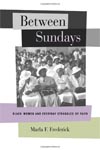 |
Frederick, Marla F. Between Sundays: Black Women and Everyday Struggles with Faith. Berkeley, CA: University of California Press, 2003.
|
 |
Hayes, Diana L. Forged in the Fiery Furnace: African American Spirituality. Maryknoll, NY: Orbis Books, 2012.
|
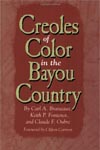 |
Brasseaux, Carl A., Keith P. Fontenot, and Claude F. Oubre. Creoles of Color in the Bayou Country. Jackson, MS: University Press of Mississippi, 1994.
|
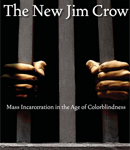 |
Alexander, Michelle. The New Jim Crow: Mass Incarceration in the Age of Colorblindness. New York, NY: The New Press, 2010.
|
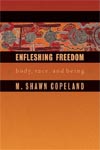 |
Copeland, M. Shawn. Enfleshing Freedom: Body, Race, and Being. Minneapolis, MN: Fortress Press, 2010.
|
Notes
1. Online Etymology Dictionary: http://www.etymonline.com/index.php?term=palm
2. Kurt Aland, ed. Synopsis of the Four Gospels (United Bible Societies, 1982), 234–236. Herman A. J. Wegman, Christian Worship in East and West: A Study Guide to Liturgical History, trans. Gordon W. Lathrop (New York: Pueblo Publishing Company, 1985), 175–176, as cited in Dr. Richard Bucher, “The History and Meaning of our Holy Week Observances,” (Lutheran Church, Missouri Synod), suggests that the formal celebrations began in the 6th century. However, Dr. Bucher notes that in fact the faithful imitated Jesus’ solemn procession into Jerusalem as early of the 4th century. Online location: http://www.orlutheran.com/html/holyweek.html. Fr. Francis X Weiner’s essay on the “History of Palm Sunday suggests that “the earliest mention of these ceremonies is found in the Sacramentary of the Abbey of Bobio in northern Italy beginning in the eight century.” Online location: http://www.catholicculture.org/culture/library/view.cfm?recnum=105. The Catholic Encyclopedia concurs with Dr. Bucher by citing the 4th century as the date the faithful in Jerusalem re-enacted Jesus’ entry into Jerusalem and the 8th century as when the “rite of the solemn blessing of the palms” was introduced. Online location: http://www.newadvent.org/cathen/11432b.htm
3. Bill Petrol’s “History of Palm Sunday: How It Starts Holy Week” notes the political implications of such a procession in Jesus’ time and acknowledges that this public display no doubt riled those who had made the formal decision to arrest Jesus months earlier. Online location: http://billpetro.com/history-of-palm-sunday
4. Grant Scott. God’s Amazing Plan (The Study of Isaiah). Online location: http://www.pbc.org/system/message_files/10561/Is45-14-25.html
5. “Blessed Hope.” By Frances E.W. Harper. Online location: http://www.ctadams.com/francesharper2.html accessed 21 December 2011.
6. “All Glory, Laud and Honor.” By Theodulph of Orleans. African American Catholic Hymnal, 1987 edition. #30
7. “Ride On, King Jesus.” Negro Spiritual. Gwendolin Sims Warren. Ev’ry Time I Feel the Spirit: 101 Best-Loved Psalms, Gospel Hymns, and Spiritual Songs of the African American Church. New York, NY: Henry Holt and Company LLC, 1997.
8. “Lead Me, Guide Me.” By Doris M. Akers. African American Heritage Hymnal. Chicago, IL: GIA Publications, 2001, #474.
|